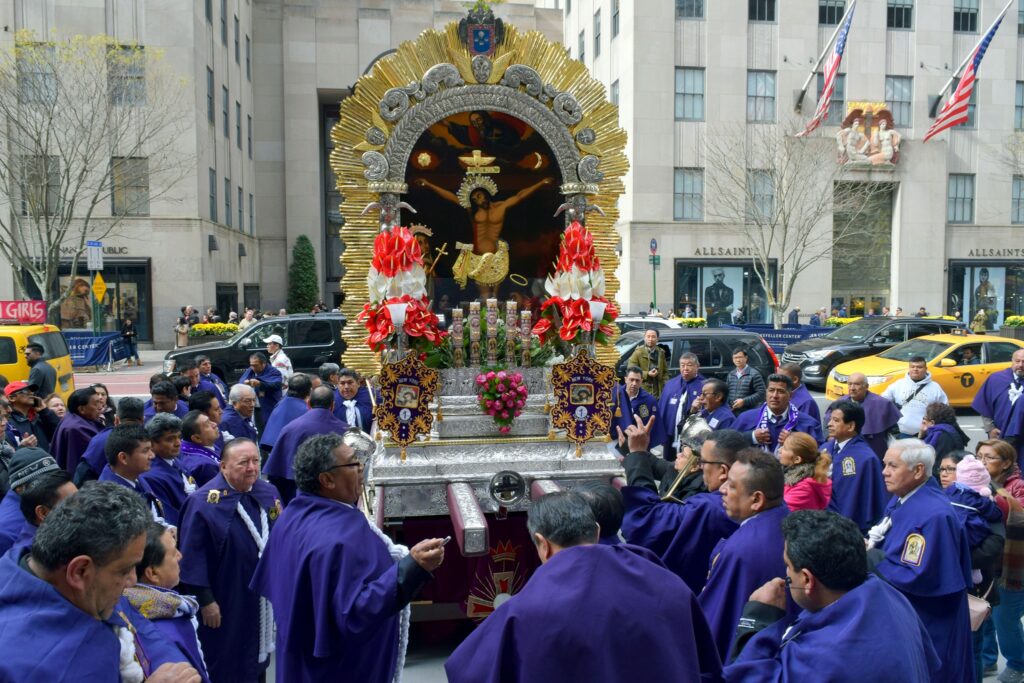
Lord of Miracles Mass (Peru) Celebrated at St. Patrick’s Cathedral
By: Armando Machado
“How many people have migrated (here) during difficult hours, but they have felt strengthened by the faith”

Archbishop Salvador Piñero Garcia-Calderon of Ayacucho o Huamanga, Peru, told the faithful, “And there is Jesus, at the hour of the cross, opening for us heaven that the sin of Adam closed,” at the annual Lord of Miracles Mass at St. Patrick’s Cathedral.
Archbishop Garcia-Calderon served as principal celebrant and homilist of the Peruvian traditional Mass, which drew more than 2,000 people on the afternoon of Sunday, October 20.
“My dear brothers and sisters, with tremendous joy, we have arrived at St. Patrick’s Cathedral,” the visiting archbishop said during welcoming remarks at the start of Mass. “Jesus, your cross illuminates us, it forgives us, and it accompanies us in the journey.” He added that he and others who traveled with him from Peru arrived “with emotion to accompany our brothers and sisters who have prepared this feast.”
“What a sincere devotion, but how profound,” Archbishop Garcia-Calderon said of the centuries of Peruvian reverence to a revered image of the Lord of Miracles. Benito or Pedro Dalcon (scholars have debated the artist’s name), an African enslaved in Peru, painted the Lord of Miracles (Señor de los Milagros) in the 17th century in Lima, Peru. Christ is depicted on the cross, with the Holy Spirit and God the Father above. On the left is the Virgin Mary, and on the right is Mary Magdalene. Its name originated in the 17th and 18th centuries after earthquakes in 1655, 1687, and 1746 destroyed most of the city, leaving only the mural standing.
Archbishop Garcia-Calderon added that the original painting and images based on the original have been “calling us to live as Church…Lord, we want to go forth and carry you (the Lord of Miracles images) with your Gospel of love for unity in families, for peace and prosperity of society.” And he noted “the mystery of God,” the Father who has given us “life and this immense and beautiful universe…And there is Jesus, at the hour of the cross, opening for us heaven that the sin of Adam closed.”
He noted that Christ is “an emblem, a sign of love” and that Mary “protects us and accompanies us in the journey.” The archbishop also said, “How many people have migrated (here) during difficult hours, but they have felt strengthened by the faith.”
Later in the homily, the archbishop spoke of the importance of Sundays, “the day of the Lord, the day of the Church… We who believe in Jesus, we’ve come to listen to His gospel, which teaches us to be sincere servants; we’ve come to celebrate… and to grow in the commandment of fraternal love – that is the importance of us congregating on Sundays.” He noted the particular significance of that October Sunday, for a gathering “filled with piety and tradition from our homeland.”
Oswaldo del Aguila, consul general of Peru in New York, served as one of the lectors. Ignacio Alvarez, president of the New York Archdiocesan Lord of Miracles Committee, gave closing remarks of gratitude. The Mass choir was Coro de la Iglesia Santa Ana from Brentwood, Long Island. An image of the Lord of Miracles was featured in the entrance procession and displayed during the Mass. In Peru, the Church of Las Nazarenas was built around the image, and a replica is carried in an annual procession in Lima, one of the largest Catholic gatherings in the world.

